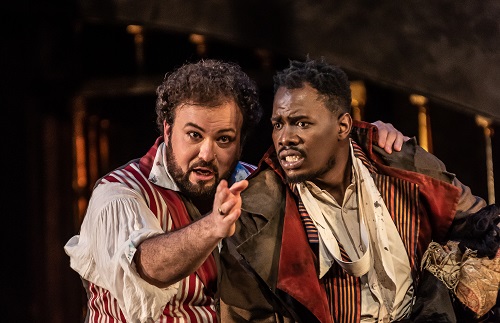Oh, what a difference a couple of months makes – Tosca returns to the Royal Opera, same production (the long-running Jonathna Kent) but with a new cast and conductor. December performances, conducted by Oksana Lyniv, starred Anna Pirozzi and Freddie de Tammaso as Tosca and her Cavaradossi.
Truth is, Tosca might as well have been a completely different piece on the evening of Tuesday 9th February. Of course, Jonathan Kent’s production remains as impressive as ever (revived here by Lucy Bradley): the split-screen finale to act one with the religious delegates above and Scarpia below (Heaven and Hell, one might say) a visual feast, the lonely perspectives of the final act, the oppressive atmosphere of the second with its violent dominating statue, all brought to dramatic perfection by the finely attuned lighting of Mark Henderson.
There were positives, most notably from the orchestra: Marco Armiliato is a known force for good on the international stage. Perhaps the handling of the final act’s lead-up to the shooting, the entrance of the soldiers, was too held back to generate a terrible momentum, but that was pretty much the one exception. The level of detail we heard was remarkable, lines carefully sculpted, interacting lines (who knew there were so many of them?) a revelation; and how accurate was the brass line that opens the final act. No wonder Armiliato was recently named Honorary Conductor of the Wiener Staatsoper.
We should remember that there is always the expectation that Puccini’s score, as an entity, is pretty indestructible: it will always generate emotion, our feelings will always be manipulated by a Scarpia-like hand, no matter what sounds come from the stage itself. It takes a lot to rob it of that.
Read on.

To be ‘pretty’ indestructible is to admit Tosca is perhaps not a fortress that can withstand all-out assault. While the minor roles were uniformly well taken, when we get to the major three (Baron Scarpia, Maria Cavaradossi and Floria Tosca), unevenness was rife. For those smaller roles, Alexander Köpeczi was a strong Sacristan in the first act, with Welsh tenor Aled Hall and English bass Simon Wilding making the most of Spoletta and Sciarrone, respectively. South African Jette Parker Company Artist Chuma Sijeqa, too, meshed fine acting with a strong baritone voice as Cesare Angelotti. Sijega is one to watch – he returns as Second Philistine in Saint-Saëns’ Samson et Dalila later in the season. He was every inch the equal of the excellent Yuriy Yurhuk in the December run.
To move to the big roles, then. Scarpia is usually portrayed as an incarnation of evil, and his actions do tend to bear out such an interpretation. As such the singer’s presence should dominate the stage, whether in that finale of the first act or in the torture and assault of the second. The experienced Michael Volle, who debuted with the Royal Opera back in 1997, enjoys a global career, but there is a niggling doubt that Scarpia is not quite ‘his’ role. The part does not quite seem to sit so well with his voice, and we miss the awe-inspiring vocal confidence – and menace – of, for instance, Bryn Terfel.
As Mario Cavaradossi, Stefan Pop, the first of the two Romanian leads, offered a ‘Recondita armonia’ so strong and unrelenting it veered towards caricature of Italianate operatic singing. The strength was certainly put to good use later as he railed against his torture in the second act, while the final act ‘E lucevan le stelle’ found tenderness creeping in.

As an audience, we need to be engaged, gripped beyond measure, immersed in the story. The final toppling of the edifice of Tosca sadly came from Romanian soprano Angela Gheorghiu, as Floria Tosca herself. Clearly, she was the star attraction – her fans clapped interruptively at the mere hint of her voice (to much shushing from the more experienced members). Gheorghiu sounded vocally unbalanced from the start, a hint of silver to her voice undermined by a general feeling of instability. Later, her ‘Vissi d’arte’ was fragile, but in the wrong way; the voice itself sounded feeble. Her acting was disengaged, stagey even, but that seemed subsidiary to worries about the voice: she clearly saved herself for the big moments but even then, she was not always audible (the moment of Tosca’s ‘kiss’ a case in point). Perhaps the low point was the moment in the final act when Puccini leaves Tosca and Cavaradossi to sing in octaves, shorn of orchestra. Odd octaves, veering towards major sevenths and minor ninths with merry abandon. By the time of the heroine’s final, famous descent to her death, emotional disengagement was total.
Tosca can, and should, be an emotionally exhausting experience. For all the devotion of the orchestra and the excellent chorus, this was a patchwork quilt of an evening that at crucial points distanced the audience from the ongoing drama.
Colin Clarke
Floria Tosca – Angela Gheorghiu, Mario Cavaradossi – Stefan Pop, Baron Scarpia – Michael Volle, Cesare Angelotti – Chuma Sijeqa, Spoletta – Aled Hall, Sciarrone – Simon Wilding, Sacristan – Alexander Köpeczi; Director – Jonathan Kent, Conductor – Marco Armiliato, Set/Costume Designer – Paul Brown, Lighting Designer – Mark Henderson, Chorus and Orchestra of the Royal Opera House.
Royal Opera House, Covent Garden, London; Tuesday 8th February 2022.
ABOVE: (Cesare Angelotti) Chuma Sijeqa, © ROH Tosca 2022/Clive Barda